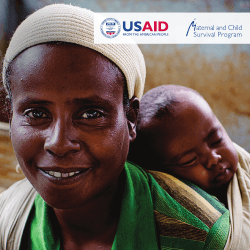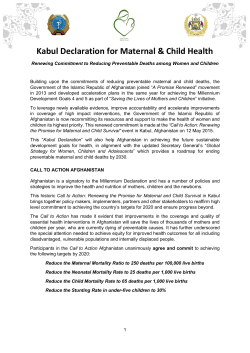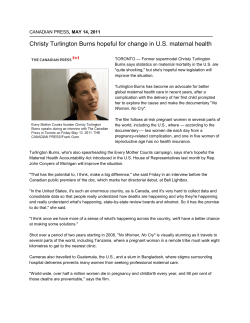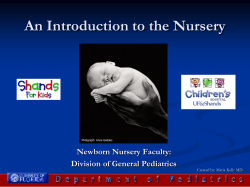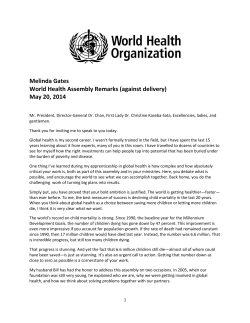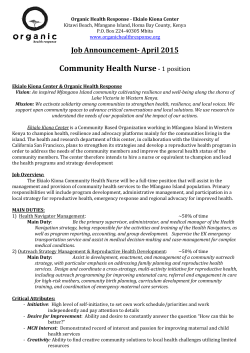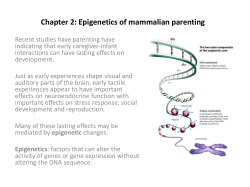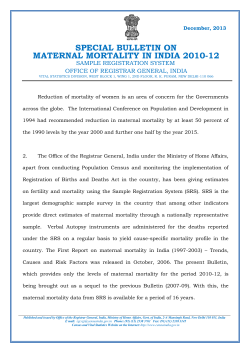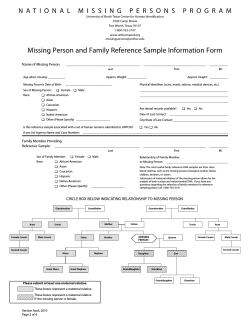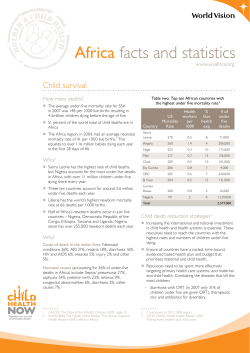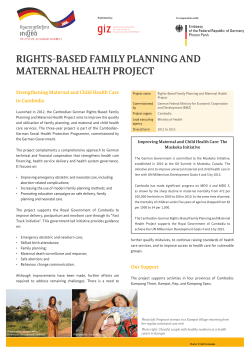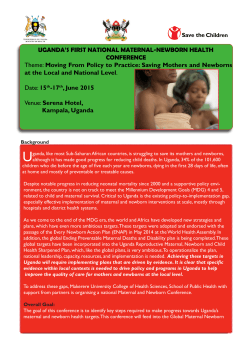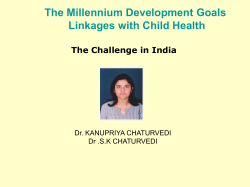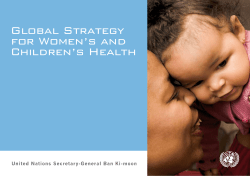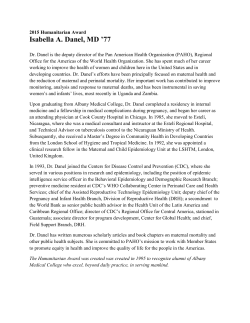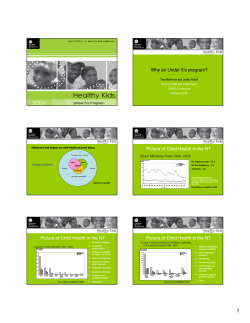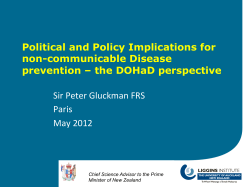
Post 2015 Framework: Partnership for Maternal, Newborn and Child Health... Summary Statement
Post 2015 Framework: Partnership for Maternal, Newborn and Child Health (PMNCH) Summary Statement Ending preventable deaths and morbidity, especially amongst women and children Everyone has a fundamental right to the highest attainable standard of health with physical, mental and social wellbeing. The foundation for sustainable social, economic and environmental development, and for peace and security, is the health of populations (healthy people, healthy planet). But thousands die every day from preventable causes and 1 the health MDGs are still an unfinished agenda . To ensure that people’s health remains a priority moving forward, the following should be included in the Post 2015 framework: Goal: Include an explicit goal focused on the health of populations, such as healthy life: ending preventable deaths 2 and morbidity, especially amongst women and children. This encompasses reproductive , maternal, newborn, 3 child and adolescent health, the prevention , diagnosis and treatment of communicable (e.g. malaria, TB, HIV, 4 pneumonia, diarrhoea etc) and non-communicable diseases, and addressing key social and environmental determinants of health such as nutrition, education, clean water and sanitation, political stability, and gender equality. Equity: Focus on the 40% of people who are at the bottom of the income pyramid so that they can have access to quality essential goods and services. Women and children in remote and marginalised communities are especially disadvantaged by poverty and ill-health. Child marriage and gender inequalities in social, economic and political participation exacerbate these problems. Access to universal health care can help prevent the vicious cycle of poverty, ill-health and unsustainable environments. Effective Investment: Recognise the importance of investing in health and strengthening health systems – An 5 investment in health is an investment in social and economic growth (healthier is wealthier) and sustainable development, and constitutes part of every country’s obligation to realise the human rights of its citizens. Delivering quality health services requires many systems elements to be strengthened, particularly the health workforce, information systems, supply chains and governance. Background6 The health of populations, how equitably quality health services are distributed, and effective health investment all contribute to the well-being of populations and to sustainable development. Today, despite widespread endorsement of health as a human right and a growing recognition of the impact of health on economic growth and development, far too many continue to die from preventable causes and experience debilitating, and sometimes life-long, illnesses. There is political momentum and progress, but much more to do. The MDGs accelerated progress by focusing on health goals and on key determinants of health. They galvanized political support and helped set global, regional and national health agendas. The MDGs also stimulated increases in domestic resources for health and development assistance and provided a platform for accountability. As we approach the 2015 deadline, we can celebrate substantial progress, but much more is needed. 7 Cross-sectoral approach. Improving health outcomes requires a joined up approach. Improving health systems and 8 coverage of essential interventions needs to go alongside efforts on access to clean water and sanitation, education , gender equality, and improved nutritional status. Gender norms often do not allow access to comprehensive sexual 9 and reproductive health information, supplies and services . Malnutrition in all forms is a major contributor to disease 10 and early deaths. It is currently the underlying cause of over a third of child deaths . Climate change and environmental degradation increase the number of extreme weather events, which in turn compromise food and nutrition security. 11 Health is closely linked to all of the Post 2015 consultation themes . The entire Post 2015 process requires an approach that is rights based, population centric, gender sensitive, health sensitive, country owned and equity focused. Only by working in this way will we improve health outcomes globally. Partnership for Maternal, Newborn and Child Health (PMNCH): LIST OF SIGNATORIES 1 2 3 4 5 6 7 8 9 10 11 12 13 14 15 16 17 18 19 20 21 22 23 24 25 26 27 28 29 30 31 32 33 34 35 36 37 38 39 40 41 42 43 34 Million Friends of the United Nations Population Fund Abibimman Foundation Africa Coalition on Maternal, Newborn and Child Health (Africa MNCH Coalition) Africa Youth for Peace and Development All India Institute of Medical Sciences (AIIMS) Alliance for Reproductive Health Rights (ARHR) Alpha O Centre For Malaria Prevention and Control Averting Maternal Death and Disability (AMDD) Azad India Foundation Bill & Melinda Gates Foundation Burnet Institute Cameroon Christian Welfare Medical Foundation (CAMCWEMEF) CARE USA Caring & Living As Neighbours - CLAN Carolina Breastfeeding Institute CEDES, Centro de Estudios de Estado y Sociedad Centre for Health and Population Studies (CHPS) Centre for International Child Health Centre for International Child Health Centre for Pregnancy & Childbirth Education (CEPACE) Centro Rosarino de Estudios Perinatales (CREP) Chelma Advisory Institute CHETNA Children's Project International Community and Family AID Foundation - CAFAF Community and Family Foundation Concept Foundation CORE Group Countdown 2015 Curamericas Global Inc. Development Media International Disease Management Association of India Doris Duke Charitable Foundation Doris Duke Charitable Foundation Dr Maimbolwa, Assistant Dean School of Medicine , University of Zambia Elizabeth Glaser Pediatric AIDs Foundation Elizka Relief Foundation - formerly Elizka Relief International Enfants du Monde Environmental and Rural Mediation Centre (ENVIRUMEDIC), Esperanza Maternal, Newborn & Child Health Centre Family Care International FAO FIGO- International Federation of Gynecology and Obstetrics 44 45 46 47 48 49 50 51 52 53 54 55 56 57 58 59 60 61 62 63 64 65 66 67 68 69 70 71 72 73 74 75 76 77 78 79 80 81 82 83 84 85 86 87 88 89 Future Generations GAVI Alliance Global Alliance to Prevent Prematurity and Stillbirth - (GAPPS) Global Network for Perinatal and Reproductive Health Global Organization for Maternal & Child Health (Go-MCH) Gram Bharati Samiti (GBS) Health Alliance International Health and Development International (HDI) Health Partners International Healthright International Healthright international Helen Keller International Horizon Youth Development (HYD) individual consultatn retired from Asian Development bank Initiative for Maternal Mortality ProgrammeAssessment - Immpact Institute for Global Health of Barcelona - ISGLOBAL Instituto de Cooperacion Social Integrare (ICSI) Instituto de Efectividad Clínica y Sanitaria (IECS) International BabyFood Action Network (IBFAN) AFRICA International Child Health Group International Confederation of Midwives International Diabetes Federation International Federation for Spina Bifida and Hydrocephalus (IF) International Federation of Pharmaceutical Wholesalers (IFPW) International Pediatric Association - IPA International Planned Parenthood Federation (IPPF) IntraHealth International, Inc. John Snow Inc./ JSI Research & Training Institute, Inc Kids & Teens Resource Centre Korea Foundation for International Healthcare (KOFIH) Krityanand UNESCO Club Liverpool Women's Hospital Local Development Agency on Reproductive and Maternal Health (LODARMAH) MACHE Initiative Mahatma Gandhi Institute of Medical Sciences March of Dimes Foundation MEDICAL STUDENT ASSOCIATION OF RWANDA (MEDSAR) Medical Women’s International Association Meera Foundation MEMISA Merck & Co. Inc. Micronutrient Initiative Mintaka Foundation for Medical Research National Center for Child Health and Development National Center for Child Health and Development (Japan) National committee for maternal and neonatal health 90 91 92 93 94 95 96 97 98 99 100 101 102 103 104 105 106 107 108 109 110 111 112 113 114 115 116 117 118 119 120 121 122 123 124 125 126 127 128 129 130 131 132 NCD Child Novartis Foundation for sustainable development Operation ASHA Organization for Public Health Intervention and Development Oslo University Hospital Partners in Population & Development (PPD) Pathfinders Peace and Life Enhancement Initiative International (PLEII) Population Council Population Matters Population Media Center Population Services International Population Services International - PSI Population studies unit, Geography Departmetn, University of Lagos Prince Leopold Institute of Tropical Medicine Antwerp Program for Appropriate Technology in Health - PATH Promundo Redeem Community Health Consult Rotarian Action Group for Population & Sustainable Development (RFPD) Royal College of Obstetricians & Gynaecologists (RCOG) SAHAYOG Save the Children Save the Mothers East Africa Simavi Social Development & Management Society Society for Education, Action, and Research in Community Health (SEARCH) The African Woman Alliance The Akaa Project The Children's Project International The Great Lakes in Action for Peace and the Sustainable Development The Hunger Project The Mother and Child Health and Education Trust The Programme for Global Paediatric Research (PGPR) The Wellbeing Foundation Treatment Advocacy and Literary Campaign (TALC) University of the Witwatersrand & Charlotte Maxeke Johannesburg Academic Hospital, South Africa WAHA - Women and Health Alliance International WaterAid White Ribbon Alliance , Zambia Women and Children First Women United for Economic Empowermet (WUEE) Women's Health and Action research Centre (WHARC) World Vision International 1 Despite a decline of 47% and 41% of maternal and child deaths respectively since 1990, every year we still lose 6.9 million children under the age of 5 and 287 000 pregnant women. For every woman who dies, approximately 20 more suffer injuries, infection and disabilities. In 2009 there were 2.6 million stillbirths, of which 1.1million are intrapartum and potentially preventable. Progress related to health has been inequitable within and between countries. For instance Sub Saharan Africa accounts for over half of all maternal and child deaths and the poor and less educated remain more vulnerable to ill health. Trends are changing with newborn deaths accounting for higher proportions of child deaths and preterm births. HIV/AIDS remains a challenge with 34 million people living with the disease in 2011; however the number of new infections has decreased by 20% since 2001. 2 This also includes the promotion and protection of rights of women and girls to have control over, and decide freely and responsibly, over matters related to sexuality and reproductive rights. 3 Including vaccination, and possible sub-targets, such as the ‘fully immunised child’. 4 This would include issues that are currently neglected such as over-nutrition (obesity), diabetes, etc. 5 One recent study by Victoria University, WHO and PMNCH (2012) estimated that for every US dollar spent on RMNCH interventions, almost 20 dollars in benefits would be generated through that investment’s effect on productivity and health care costs. 6 Partnership for Maternal, Newborn and Child Health. Women and Children’s Health in the post-2015 Development Agenda. Geneva. January 2013. Available at: http://www.google.com/url?sa=t&rct=j&q=&esrc=s&frm=1&source=web&cd=1&ved=0CDQQFjAA&url=http%3A%2F%2Fwww.who.int%2Fpmnch %2Fmedia%2Fnews%2F2012%2F20130103_pmnch_post_2015.pdf&ei=owQZUd6fBoOE4gSLyYCwCQ&usg=AFQjCNHX1uHZKMMVG9Jjh2wYzhoL wfFcOQ&sig2=vTnyWXF1iLpowQdP1DggWQ&bvm=bv.42080656,d.bGE 7 Usually called an integrated approach. 8 For example, Of 8·2 million fewer deaths in children younger than 5 years between 1970 and 2009, 51·2% could be attributed to increased educational attainment in women of reproductive age(15-44years). Gakidou E, Cowling K, Lozano R, Murray CJL. Increased educational attainment and its effect on child mortality in 175 countries between 1970 and 2009: a systematic analysis. The Lancet. 2010; 376:959–974. 9 Communiqué from the Meeting of the High-level Panel of Eminent Persons on the Post-2015 Development Agenda . Monrovia, Liberia. February 2013. Available at : http://www.google.com/url?sa=t&rct=j&q=&esrc=s&frm=1&source=web&cd=4&cad=rja&ved=0CEsQFjAD&url=http%3A%2F%2Fwww.un.org%2 Fsg%2Fmanagement%2Fpdf%2FMonrovia_Communique_1_Feb_2013.pdf&ei=XFw_UczRK8KdtQbj2YGwAg&usg=AFQjCNG_0GyXMjBYc1pPwHXMoo3cR5rRg&sig2=H_uEXYzgp2toDfFZ-n2hOQ 10 UNICEF, WHO, World Bank, UN. Levels and Trends in Child Mortality: Report 2012 – Estimates Developed by the UN Inter-Agency Group on Child Mortality Estimation. New York. 2012. 11 Health, Conflict and Fragility, Governance, Inequalities, Environmental Sustainability, Economic Growth and Employment, Population, Water, Energy, Education, Food Security and Nutrition.
© Copyright 2025
